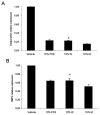Endocrine and Metabolic Effects of Adipose Tissue in Children and Adolescents
- PMID: 27646920
- PMCID: PMC4820166
- DOI: 10.1515/sjph-2015-0020
Endocrine and Metabolic Effects of Adipose Tissue in Children and Adolescents
Abstract
Adipose tissue is implicated in many endocrine and metabolic processes. Leptin was among the first identified adipose-secreted factors, which act in an auto-, para- and endocrine manner. Since leptin, many other adipose tissue factors were determined, some primarily secreted from the adipocytes, some from other cells of the adipose tissue. So-called adipokines are not only involved in obesity and its complications, as are insulin resistance, type 2 diabetes and other components of the metabolic syndrome, but also in growth, reproduction, bone metabolism, immune response, cancer development and many other important biological processes. Research in the field of adipokines has revealed new insights into the physiological and pathophysiologal processes and opened new therapeutic possibilities. In the present article, a special emphasis is devoted to research in children and adolescents.
Maščobno tkivo ima vlogo pri številnih endokrinih in presnovnih procesih. Lepin je bil med prvimi odkritimi dejavniki iz maščobnega tkiva, ki delujejo avto-, para- in endokrino. Od opredelitve leptina so odkrili še številne druge dejavnike, od katerih se nekateri izločajo iz maščobnih celic, nekateri pa iz drugih celic maščobnega tkiva.Tako imenovani adipokini niso povezani le z debelostjo in njenimi zapleti, kot so rezistenca proti inzulinu, sladkorna bolezen tipa 2 in druge komponente metabolnega sindroma, temveč tudi z rastjo, razmnoževanjem, presnovo kosti, imunskim odzivom, razvojem rakavih bolezni in mnogimi drugimi pomembnimi biološkimi procesi. Raziskave na področju adipokinov so opredelile nove fiziološke in patofiziološke procese in odprle nove možnosti zdravljenja. V tem prispevku poseben poudarek namenjamo raziskavam pri otrocih in mladostnikih.
Keywords: adipokine; adipose tissue; child; endocrinology; metabolic syndrome; obesity.
Figures

References
-
- Zhang Y, Proenca R, Maffei M, Barone M, Leopold L, Friedman JM. Positional cloning of the mouse obese gene and its human homologue. Nature. 1994;372:425–32. - PubMed
-
- Chen H, Charlat O, Tartaglia LA, Woolf EA, Weng X, Ellis SJ, et al. Evidence that the diabetes gene encodes the leptin receptor: identification of a mutation in the leptin receptor gene in db/db mice. Cell. 1996;84:491–5. - PubMed
-
- Halaas JL, Gajiwala KS, Maffei M, Cohen SL, Chait BT, Rabinowitz D, et al. Weight-reducing effects of the plasma protein encoded by the obese gene. Science. 1995;269:543–6. - PubMed
-
- Lonnqvist F, Arner P, Nordfors L, Schalling M. Overexpression of the obese (ob) gene in adipose tissue of human obese subjects. Nat Med. 1995;1:950–3. - PubMed
-
- Caprio S, Tamborlane WV, Silver D, Robinson C, Leibel R, McCarthy S, et al. Hyperleptinemia: an early sign of juvenile obesity: relations to body fat depots and insulin concentrations. Am J Physiol. 1996;271:E626–30. - PubMed
Publication types
LinkOut - more resources
Full Text Sources
Other Literature Sources
